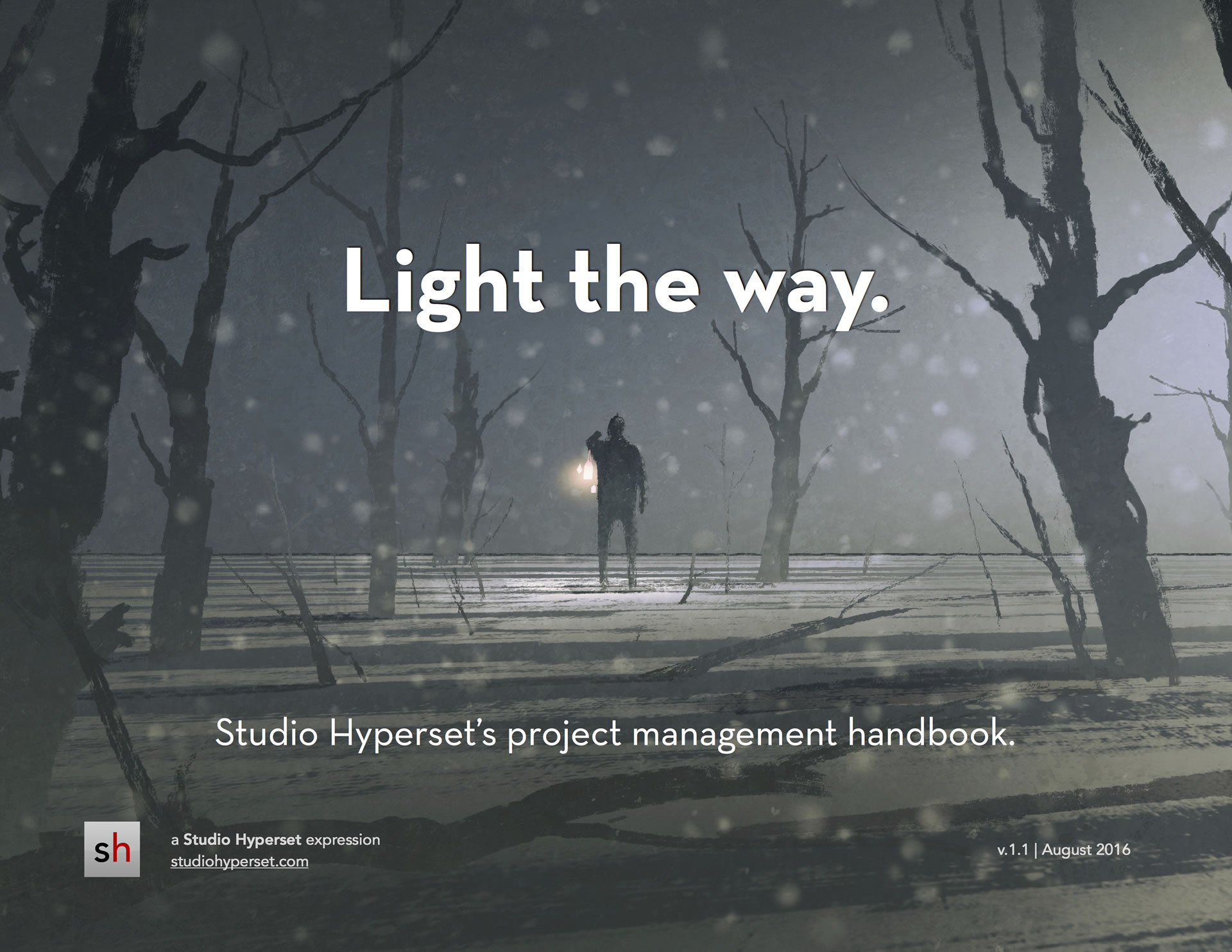3 Project Management Best Practices
by
Quimby Melton
June 13, 2016 | Leave a comment
Updated August 21, 2016
“Not too chatty” + “Let there be light” + “Mind the gap(s)”

As I’ve written elsewhere, project management is really exciting and really important. It’s the steady north star at the center of any successful venture, and, at Studio Hyperset, we’ve spent the past decade placing it at the center of everything we do.
Doing so has allowed us to build two valuable things for our clients:
- an ultra-responsive support and operations framework
- a talented team of reliable, client-focused creative professionals
These resources help SH operate faster, and handle more volume, than many other creative individuals and agencies. Our project management systems — which leverage 24/7 global communication, intuitive workflows, and technology solutions — minimize most common frustrations associated with the client/agency relationship:
- tangled email chains
- endless follow ups
- unresponsive talent
These systems also help put tremendous downward pressure on development and review cycles, increase speed to market, and streamline the processes of creating content and executing marketing strategies. However, I hope they also help our clients feel as if they’re our most important asset (because they are).
As all this might suggest, project management is a sort of religion to me. Like most everyone else, I’ve experienced the world (and professional situations) when it’s been proactively present and passively absent, and there’s no contest which facilitates the best relationships and which maximizes happiness, catharsis, and intended results.
Just like a reader or a critic, great project managers focus on creating greater clarity than would otherwise exist. The role’s special genius lies in transforming stochastic “noise” into harmonized order and creating a space in which creative actions can flourish. Challenging artworks without critical voices are just jumbles of signs. Likewise, projects without project managers are generally nightmares of entropy.
When we say SH’s mission involves creating catharsis, this is exactly what we mean. Project managers are light-bringers and deus ex machina figures. They prevent problems from happening and solve them when they arise. They’re the agents of catharsis and the essential bridge between clients and creatives. In this capacity, they allow each to collaborate harmoniously and constructively and thereby facilitate:
- the building of bridges outward to audiences
- the creation of engaging solutions for complex challenges.
Bottlenecks — stalls in an otherwise fluid workflow — are unappealing and best avoided, and I always want SH to be the fastest, most efficient service shop on the block. However, when we must choose, we always sacrifice raw speed for the core values of good project management:
- balance
- order
- clarity
- gentility
- grace
Each of these have tremendous enduring value.
At a high-level, our project management philosophy involves the following three principles. We use these every day to ensure our operations systems run as efficiently as possible.
 “Not too chatty.”
“Not too chatty.”
We use minimum constructive dialogue to achieve maximum results. We want to be responsive and action-oriented without fatiguing clients with too much dialogue or over-sharing.
As a result, a client might not see every discussion or to do. Basecamp — the client-facing portion of our project management stack — allows us to select which content clients can and cannot see, and keeping some activity private allows us to facilitate the “Not too chatty” principle.
If clients feel they don’t have an adequate high-level view, are curious about something that’s outstanding, or need clarification, we ask them to post a public message in Basecamp. We’re happy to fill them in and, if necessary, reveal the to do, file, discussion, &c.
Likewise, if a client feels there’s too much chatter, we ask them to let us know that as well. We can always adjust our privacy settings.
“Let there be light!”
It’s inevitable that, at certain points the “Not too chatty” principle will conflict with this one. In these cases, we ask clients to communicate their preferences to us, and we’ll accommodate them.
However, by default, we want to make sure the status of open items is transparent and self-evident. Anyone attached to one of our projects should be able to learn, within a few moments of reading:
- the overall project status
- the status of a given to do and/or why that to do hasn’t yet been completed
 Generally, we manage this on the to-do level by adding notes such as “[In Progress],” “[Review],” “[Question],” or “[Pending]” in front of an open action item.
Generally, we manage this on the to-do level by adding notes such as “[In Progress],” “[Review],” “[Question],” or “[Pending]” in front of an open action item.
 “Mind the gap(s).”
“Mind the gap(s).”
As businesses grow and projects increase in complexity, gaps begin to form between important silos and the players in those silos: marketing and sales, marketing and product(ion), engineering and marketing, leadership and talent, &c.
It’s our job to mind these gaps, anticipate any potential communications shortfalls, bridge any kinetic communications shortfalls, and build systems that improve alignment and clarity.
Be a Project Management Hero
Download this eBook

Learn how effective communication systems can help you build great relationships with customers and teammates.
